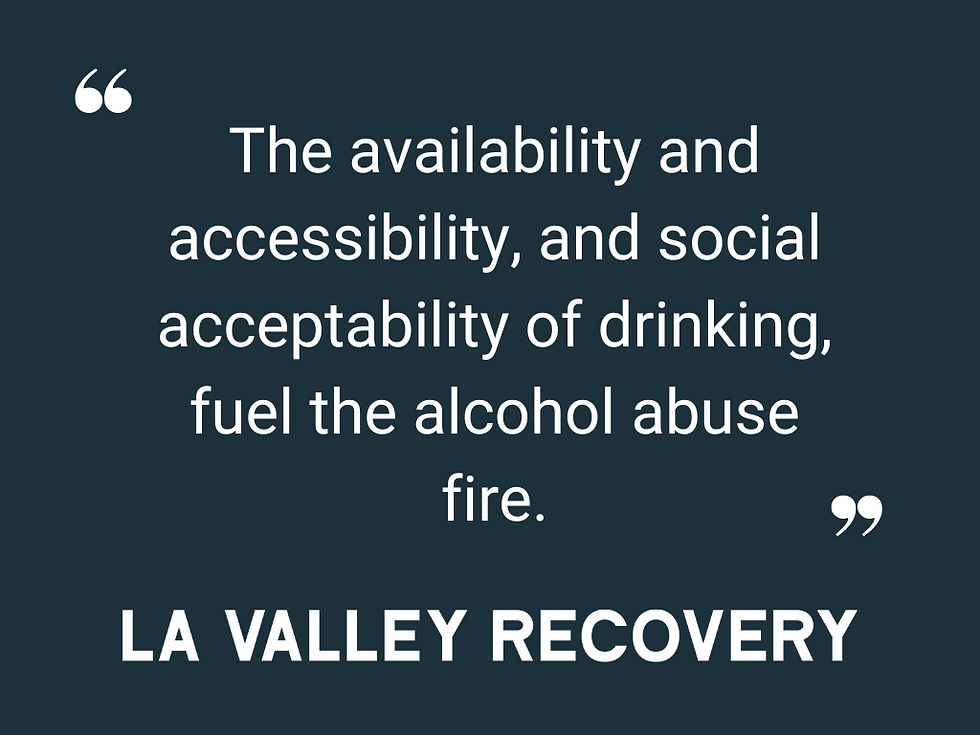Facts About Inpatient Treatment For Alcohol Abuse
- Anthony Ciarrocchi

- Oct 15, 2022
- 4 min read
Alcohol is the most commonly abused substance in the United States. The availability and accessibility, and social acceptability of drinking fuel the alcohol abuse fire. Alcohol is a dangerous substance to remove from the human body after dependency has kicked in. Alcohol withdrawal is one of the few substance withdrawals that can be fatal in itself. For this reason, finding the right treatment option is very important. When it comes to treatment for alcohol abuse, there are many options out there, so no matter who you are, there is a treatment program for you. Substance abuse treatment centers often offer “Dual Diagnosis” services if you also struggle with mental health disorders such as anxiety, depression, bipolar disorders, and many more. Knowing what to look for when choosing the inpatient treatment program for you can be tricky due to the many options, but knowing the facts about treatment for alcohol abuse can help guide the way.

Alcohol Facts
Alcohol is classified as a depressant. Depressants affect the central nervous system by slowing down the messages sent between the brain and body. Excessive drinking causes the brain to adapt to the depressant effects of alcohol. This adaptation causes the drinker to consume more alcohol to feel the impact. There are 3 million worldwide deaths directly related to alcohol every year. According to the World Health Organization, approximately 13.5% of deaths in those between the ages of 20-39 are directly attributed to alcohol. Alcohol abuse is undeniably detrimental to the lives of those abusing alcohol, but what can be overlooked is the detriment it causes the families, friends, and loved ones of those suffering from alcohol abuse.
Inpatient Treatment Facts
Inpatient treatment for alcohol abuse is an individualized process that involves three stages. Detox, Residential, and Aftercare treatment services have been designed to promote long-term abstinence from all substances. There are countless options for treatment services, and sometimes all it takes is knowing what to look for when seeking treatment for alcohol abuse. There are gender-specific programs, co-ed programs, religious programs, evidence-based programs, 12-step-based programs, and many, many more.
12-step-based programs are typically the most common and can be combined with aspects of spirituality. There are numerous 12-step recovery programs such as Alcoholics Anonymous, Narcotics Anonymous, Co-Dependency Anonymous, and others specific to certain substances.
Take a look at your situation and begin to make a list of the things you will need to commit to a treatment program, and from there, you will begin your search!

Detoxification Facts
Step one to treating your alcohol abuse disorder is “Detox.” Detoxing from alcohol can be extremely uncomfortable and dangerous if you try to do it yourself. Various withdrawal symptoms commonly occur during this detox period.
Some of the symptoms include:
● Anxiety
● Shakiness
● Sweating
● Agitation
● Restlessness
● Irritability
● Nausea
● Vomiting
● Increased Heart Rate
● Tremors
● Disorientation
● Seizures
● Insomnia
● Death
Detox is the most critical inpatient treatment for alcohol and other substance abuse disorders. During this time, there will be dedicated medical and clinical members that are monitoring the physical and mental symptoms related to withdrawal.
Alcohol Withdrawal Syndrome (AWS) is the syndrome in which a heavy drinker suddenly removes alcohol from the body. AWS may cause a combination of physical, mental, and emotional symptoms that range from anxiety at a minimum, and death in the most extreme case.
Residential Treatment Facts
Step two of the treatment process is called the “Residential” level of care. During this portion of treatment, you will gain the coping skills and recovery tools needed to continue in life while abstinent from all substances. The withdrawal period has mostly subsided, and your mind begins to think clearly again.
Taking the time to know what to look for when searching for a program with a residential treatment program that fits you will be a major benefit. Residential programs vary depending on the location, but this is where normalizing a productive routine begins.
While in a residential treatment program for alcohol abuse, there is continuous 24/7 supervision. You will begin integrating into group sessions with other patients, which helps build communication skills, life skills, and healthy boundaries.
The “Pink Cloud” effect usually begins during residential treatment. This can be described as a euphoric period where confidence and excitement about recovery happen. The “Pink Cloud” period can help boost confidence in the recovery process, but it does eventually end. Residential treatment supports those finishing the detox stage and when the “Pink Cloud” effect begins to wear off. This is a normal part of recovery, so do not beat yourself up when you are experiencing some deep feelings and emotions. When the brain is readjusting to life without those substances, the ups and downs of emotions are normal. Residential treatment provides support to work through the highs and lows during this period. Ultimately, it creates stronger coping skills and recovery tools to work through all ranges of emotions.

Summing It Up
Find yourself staring down the barrel of active addiction and want real change in your life. Knowing the facts about treatment for alcohol abuse will be your best starting point. Accepting that there is help for you may be challenging, so knowing the risks, the ups, the downs, and the in-betweens of the recovery process will prepare you to make a lifelong change.






Comments